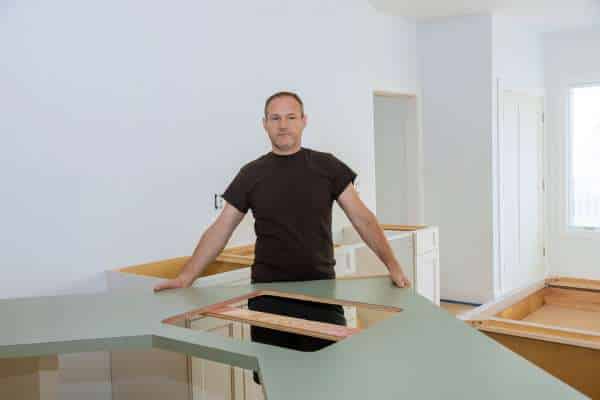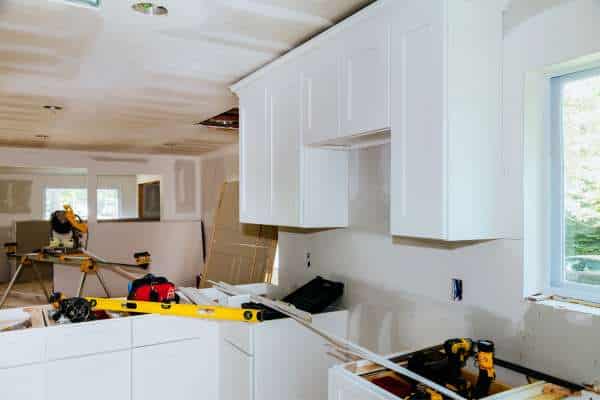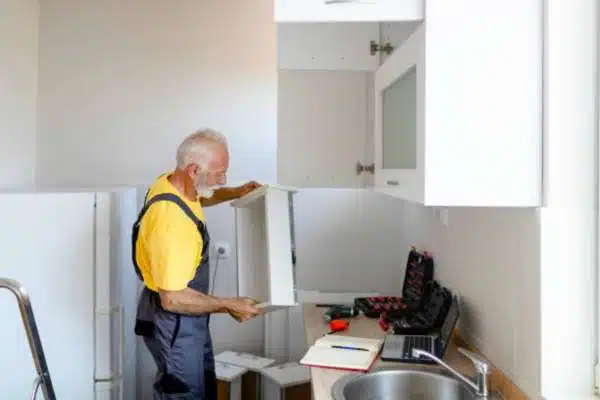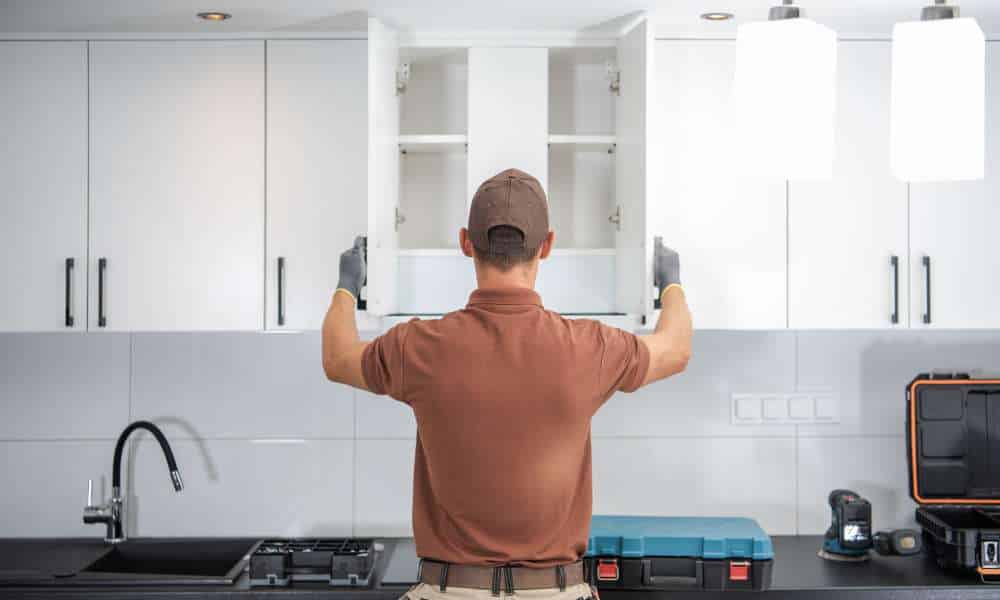Embarking on a kitchen renovation journey begins with a crucial step: learning how to remove old kitchen cabinets. This foundational task not only paves the way for a fresh, modern update to one of the most vital spaces in your home but also offers a unique opportunity to re-envision your kitchen’s layout, functionality, and aesthetic appeal. Understanding the importance of this process is key, as it ensures safety, efficiency, and a smooth transition to installing new cabinetry. By equipping yourself with the right knowledge and tools, you can confidently undertake this project, making room for new possibilities in your kitchen’s design and usability.
What Tools Do I Need To Remove Old Kitchen Cabinets?
Removing old kitchen cabinets requires a few essential tools to ensure a smooth and efficient process. Firstly, you will need a screwdriver or power drill with appropriate bits to remove screws holding the cabinets in place. A pry bar can also be helpful for gently prying the cabinets away from the wall without causing damage.
Can I Remove Old Kitchen Cabinets By Myself?
It is important to assess the condition of the cabinets and the surrounding area to determine if there are any potential hazards or obstacles that may impede the removal process. If you are unsure about your ability to safely remove the cabinets or if you encounter any difficulties during the process, it is recommended to seek professional assistance from a contractor or carpenter who has experience in cabinet removal.
Disposal Or Recycling Options
1. Checking Local Regulations For Disposal
Before embarking on the removal of your kitchen cabinets, it’s crucial to familiarize yourself with local regulations regarding the disposal of construction and renovation waste. Many municipalities have specific guidelines that dictate how and where to dispose of such materials. Ensuring compliance with these regulations can prevent potential fines and supports environmentally friendly disposal practices. This research phase is an integral part of the project planning, safeguarding that the process aligns with community standards and contributes to sustainable development efforts.
2. Donating Reusable Cabinets And Materials
One of the most rewarding aspects of removing old kitchen cabinets is the opportunity to donate them. Many organizations and non-profits accept usable cabinets and building materials, offering them a second life in homes that need them. This not only diverts waste from landfills but also supports community development projects. Before dismantling your cabinets, consider assessing their condition to see if they’re suitable for donation. This act of giving not only benefits the environment but also enriches the lives of others, making it a win-win situation.
3. Recycling Wood And Metal Components

Recycling is another excellent option for disposing of your old kitchen cabinets, especially if they’re not in a condition to be donated. Wood components can often be recycled into new products or biofuel, while metal parts can be melted down and reused. This process significantly reduces the amount of waste sent to landfills and contributes to the conservation of natural resources. Contact local recycling centers to find out about their policies regarding kitchen cabinets and whether they accept wood and metal parts.
Labeling Hardware For Reassembly

Labeling hardware for reassembly is a crucial step when undertaking the removal of old kitchen cabinets. By carefully labeling and organizing each piece of hardware, such as screws, hinges, and handles, you can streamline the reassembly process and avoid any confusion or missing parts. One effective method is to use small plastic bags or containers to group and label each set of hardware according to its specific location in the cabinet.
Detaching Countertops From Cabinets

Detaching countertops from cabinets is a crucial step in updating your kitchen decor, especially when considering how to decorate a large kitchen island. This process requires precision and patience to ensure that the countertop is removed without causing damage. One innovative approach is using heat guns or hairdryers to soften any adhesive or caulking holding the countertop in place. Additionally, using a putty knife or pry bar can help loosen the countertop without harming the surrounding cabinets.
Disconnecting Electrical Outlets
Safety should always be a top priority when removing old kitchen cabinets, particularly when electrical outlets are involved. Before initiating the removal process, it’s imperative to disconnect any electrical power running to the kitchen to prevent accidents. This might involve turning off the power at the circuit breaker and using a voltage tester to ensure that no current flows through the outlets. Carefully remove the outlet covers and detach the wiring, keeping in mind to label each wire for easy reconnection later. This precaution not only safeguards your well-being but also protects the integrity of your home’s electrical system, ensuring a safe environment for your kitchen renovation project.
Lifting Cabinets Carefully To Avoid Damage

Lifting cabinets carefully also involves ensuring a solid grip on the cabinet itself, avoiding grabbing onto any fragile or weak spots that may cause breakage. Utilize proper lifting equipment such as straps or grips for added safety and support. Remember, taking the time to lift cabinets carefully will not only protect the cabinets themselves but also prevent potential injury or accidents during the removal process.
Planning For Repairs Or Renovations

With the cabinets removed, you have a unique opportunity to address any hidden issues or make enhancements to your kitchen space. Inspect the walls, flooring, and electrical and plumbing systems for any signs of wear, damage, or outdated components. Planning for repairs or upgrades at this stage allows for a smoother renovation process and can improve the functionality and safety of your kitchen. Whether it’s patching and painting walls, upgrading electrical wiring, or adjusting plumbing to accommodate new fixtures, taking the time to make these improvements can significantly impact the overall quality and value of your renovation project.
Hiring Contractors For Specialized Tasks

Hiring contractors for specialized tasks like removing old kitchen cabinets allows homeowners to benefit from their access to specialized tools and equipment that are necessary for the job. This not only ensures safety during the removal process but also guarantees a high-quality outcome that meets both aesthetic and functional requirements. Ultimately, choosing to hire professionals for these types of projects can save time, effort, and money in the long run while delivering results that exceed expectations.
Exploring Diy Projects For Cabinet Reuse

By exploring DIY projects for cabinet reuse, you can give new life to old materials while also personalizing your home decor in a sustainable way. Whether upcycling entire cabinets into new furniture pieces or incorporating smaller elements into innovative designs, there are endless possibilities for transforming discarded cabinetry into functional and visually appealing additions to your space.
The Final Thought
To remove old kitchen cabinets can be a challenging yet rewarding task that can rejuvenate the look of your kitchen. By following the step-by-step guide provided in this article, you can successfully navigate the process with efficiency and care. Remember to prioritize safety by using appropriate tools and seeking assistance if needed. Once the old cabinets are removed, you will have a blank canvas to explore new design possibilities and enhance the functionality of your kitchen space. Take this opportunity to create a fresh and inviting environment that suits your personal style and preferences.

